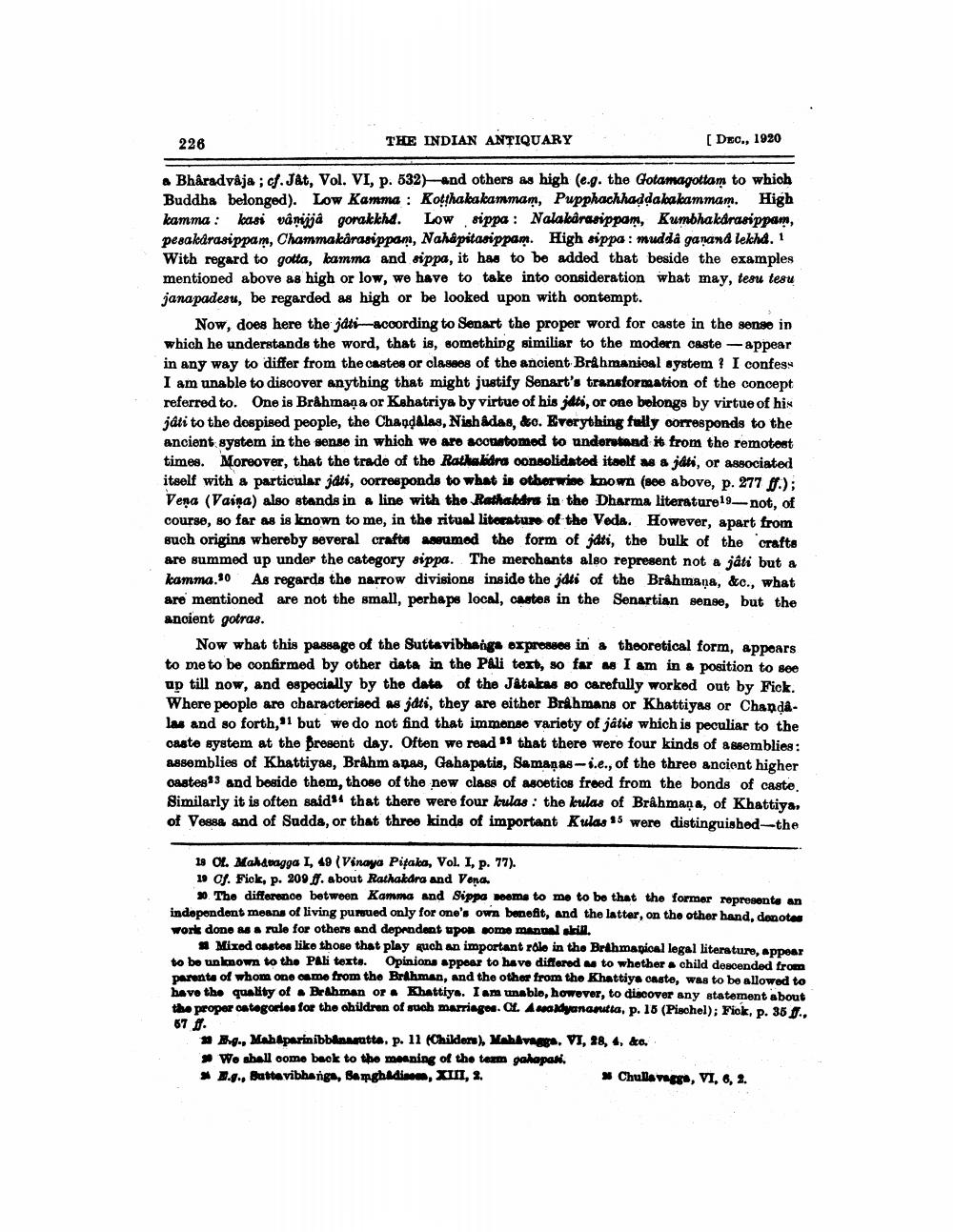________________
226
THE INDIAN ANTIQUARY
[ DEC., 1920
a Bharadvaja ; cf.Jật, Vol. VI, p. 532) and others as high (e.g. the Gotamagottam to which Buddha belonged). Low Kamma : Kothakakammam, Pupphachhaddakakammam. High kamma: kasi vâmijja gorakkha. Low sippa : Nalakärasippam, Kumbhakarasippam, pesakdrasippam, Chammakarasippan, Nahápitasippam. High sippa : mudda ganand lekhd. 1 With regard to gotta, kamma and sippa, it has to be added that beside the examples mentioned above as high or low, we have to take into consideration what may, tesu tesu janapadesu, be regarded as high or be looked upon with oontempt.
Now, does here the jati according to Senart the proper word for caste in the sense in which he understands the word, that is, something similiar to the modern caste - appear in any way to differ from the castes or classes of the ancient Brahmanioal system ? I confess I am unable to discover anything that might justify Senart's transformation of the concept referred to. One is Brahmana or Kshatriya by virtue of his juti, or one belongs by virtue of his jati to the dospised people, the Chaqdalas, Nishadas, &o. Everything fully corresponds to the ancient system in the sense in which we are aconatomod to understand it from the remotest times. Moreover, that the trade of the Ratha bidra consolidated itself as a ját, or associated itself with a particular jati, oorresponds to what is otherwise known (see above, p. 277 ff.); Vena (Vaiņa) also stands in a line with the Rasha.bara in the Dharma literature19_not, of course, so far as is known to me, in the ritual literature of the Veda. However, apart from such origins whereby several crafte asumed the form of jati, the bulk of the crafts are summed up under the category sippa. The merchants also represent not a jati but a kamma.30 As regards the narrow divisions inside the jdli of the Brahmaņa, &c., what are mentioned are not the small, perhaps local, castes in the Senartian sense, but the ancient gotras.
Now what this passage of the Suttevibhanga oxpresses in a theoretical form, appears to me to be confirmed by other data in the Pali text, so far as I am in a position to see up till now, and especially by the data of the Jatakas so carefully worked out by Fick. Where people are characterisod as jati, they are either Brahmans or Khattiyas or Chandalas and so forth, 1 but we do not find that immense varioty of játis which is peculiar to the oaste system at the present day. Often we read that there were four kinds of assemblies: assemblies of Khattiyas, Brahm anas, Gahapatis, Semaņas-s.e., of the three ancient higher oastes83 and beside them, those of the new class of ascetics freed from the bonds of caste. Similarly it is often said that there were four lulas : the kulas of Brahmana, of Khattiya, of Vesse and of Sudda, or that three kinds of important Kulas 5 were distinguished the
19 OL. Mahdoagga L, 49 (Vinaya Pitaka, Vol. I, p. 77). 19 Cf. Fick, p. 209.7. about Rathakdra and Vona.
0 The difference between Kamma and Sippa rooms to me to be that the former represente an independent means of living pumued only for one's own benefit, and the latter, on the other hand, denotes work dono as rule for others and dependent upon some manual skill.
Mixed omstes like those that play much an important role in the Brihmapical legal literature, appear to be unknown to the PAli toxto. Opinions appear to have differed to whether child descended from parenta of whom one came from tho Brahman, and the other from the Khattiya caste, was to be allowed to have the quality of Brahman or Khattiya. I am unablo, however, to discover any statement about the proper oategories for the children of such marriage. Cl. A sadyanamitta. p. 18 (Pischel); Fiok, p. 35., 67 f.
# Do., Mahaparinibbongatta. p. 11 (Childers), Mahanaga. VI, 18, 4, &o.
Wo shall come back to the meaning of the texm gahapani. 2.9., Battavibhanga, Samghadinen, XII, 2.
» Chulavage, VI, 6, 2.




